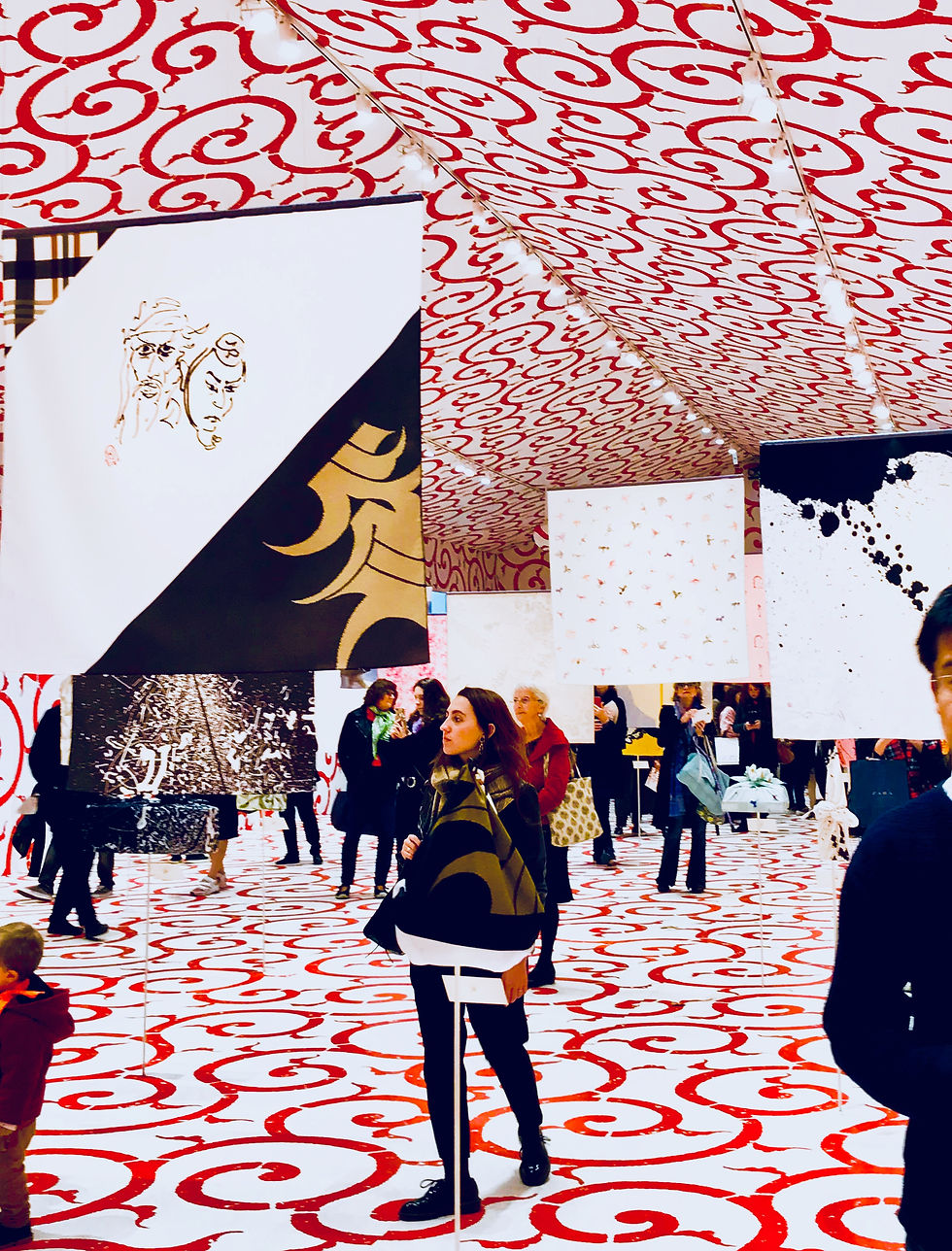
Pour 6 jours cet mois, une grande tente rectangulaire, blanche et rouge était installé au parvis d’Hôtel de Ville. Elle avait une énorme nœud dessus. Qu’est-ce que c’est ? En fait, c’était un cadeau de Tokyo à Paris pour célébrer le 160e anniversaire des relations diplomatiques entre le Japon et la France avec la série d’événements organisés en France JAPONISME 2018.
For six days this month, a large rectangular, red and white tent was installed on the plaza in front of the Hôtel de Ville (City Hall). It sported an enormous bow on top. What was it, I wondered. Mind you, it is not at all unusual to see some sort of temporary structure in front of City Hall….in fact, what is unusual is for the plaza to be empty for there is ALWAYS something going on there. But this tent was particularly striking and turns out, it was a gift from the City of Tokyo to the City of Paris in celebration of the 160th anniversary of diplomatic relations between Japan and France and part of a series of events organized in France as part of JAPONISME 2018.


Waiting to enter the pavilion
Le thème de cette fois-ci est l’environnement. En 2016, la France a pris l’initiative d’interdire les sacs plastiques. Le furoshiki fait partie de la tradition japonaise. Le furoshiki est un morceau de tissu unique qui est utilisé pour emballer un cadeau peut être rapporté chez soi puis utilisé a nouveau lorsqu’il s’agit de rendre la faveur. La durabilité, c’est exactement cela. Il s’agit d’une alternative aux « eco-bag .» Autrefois, les bureaucrates de Kasumigaseki servaient de furoshiki pour protéger leur documents. On parle parfois de « furoshikible, » jeu de mot qui souligne que le furoshiki emballe aussi bien les grandes que les petites choses.
The theme of this event was the environment. The project's Art Director, architect Tsuyoshi Tane, said he first considered wrapping the Eiffel Tower (à la Christo!) but abandoned the idea because to do so would have interfered with radio wave transmissions. Wrapping the Louvre's pyramid was also considered, but in the end, a furoshiki pavilion at City Hall won the day. France had taken the initiative in 2016 to ban plastic bags and has long encouraged its citizens to carry their own reusable bags for shopping. The furoshiki was in a sense the first reusable or “eco bag,” its use dating back to 8th century Japan. It's a piece of square cloth that can be used to wrap a gift and will likely be used again either for the same purpose or simply as a way to carry something. In fact, in the past Japanese government bureaucrats used furoshiki to protect their many documents. One sometimes says that something is “furoshikible” which stresses that the furoshiki wraps not only large and valuable things, but things small and insignificant as well.

A furoshiki and how it's used to wrap something
Donc j’ai voulu aller et voir pour moi-même ce qui est le furoshiki. Il y avait une queue l’après-midi que je suis allée, mais ce n’était pas longue, donc j’ai attendé, et j’étais tellement ravi de le faire. Quand j’entrais le pavillon, j’ai arrêté et j’ai dit : « WOW !» L’intérieur, les murs, les plafonds et les planchers, tous était le même tissu de l’extérieur….c’était exquis ! Suspendus au plafond étaient des furoshikis originaux et traditionnels mais aussi dessinés par des artistes contemporains japonais et français.
So I was curious to go and see for myself the furoshiki. The afternoon I went (actually the last day), there was a line to get in. It wasn’t long, however, so I waited and I was so very glad I did. When I entered the pavilion, I literally stopped, my jaw dropped and I whispered “WOW!” It was not at all what I expected (though I didn’t really have any expectations) and it was a visual feast. The entire interior was the same red and white fabric as the exterior of the tent….walls, ceiling and floor. And the effect was striking. Suspended on thin wires from the ceiling were square furoshiki, some traditional designs and some new, designed by contemporary Japanese and French artists.

Inside the pavilion...what a surprise!

The first section featured hanging furoshikis with something wrapped in the same furoshiki




The second section featured items of all shapes and sizes wrapped in different furoshiki






The third section was a large table where people could try their hand at wrapping with furoshiki. iPads showed video demonstrations of how to do it.
Contrairement à un sac ordinaire, utiliser un furoshiki requiert d’y investir une part de soi sans quoi il perd ce qui fait sa force. Une telle spiritualité est également contenue dans le furoshiki. Donc ce n’est pas seulement le premier « eco bag, » mais il s’agissait en fait de faire apparaitre la culture et la spriritualité du Japon.
Unlike an ordinary bag, to use a furoshiki requires that one invest a part of onself in the wrapping. A real sense of spirituality is contained in the furoshiki. So this gift from Tokyo to Paris is not just the first “eco bag,” it is a gift that embodies both the culture and the spirituality of Japan….a most special gift indeed!


In addition, the many statues at Hôtel de Ville sported their own furoshikis
